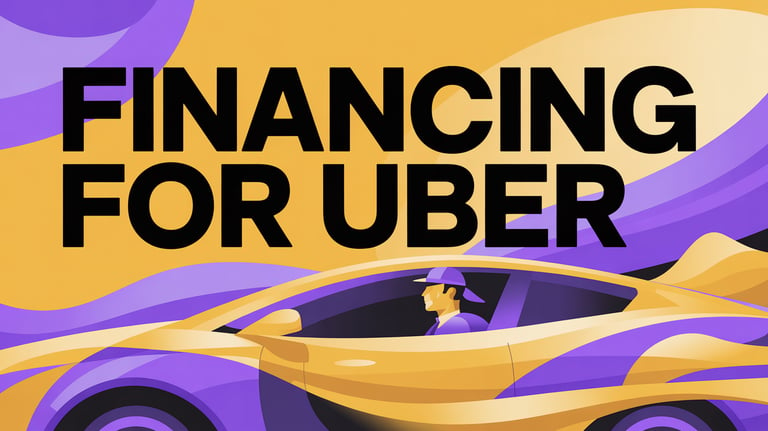Unveiling Uber’s Hidden Secret:
How Financing Your Car Can Boost Your Success
Financing a Car for Uber in North America:
Your Roadmap to Financial Freedom
Thinking about becoming an Uber driver in North America? Uncertain economic times shouldn't hold you back! This comprehensive guide unlocks the secrets of car financing for Uber drivers, offering two tailored 10-step plans.
Get Approved for Financing (Even with Limited Credit History): Our first guide equips you with the knowledge to navigate the financing process, regardless of your credit history.
Canadian Newcomer?
Drive Your Way to Success: Our second guide provides a step-by-step breakdown specifically for Canadian immigrants looking to finance a car for Uber with earnings from driving.


Considering Uber driving in North America? Don't let car ownership hold you back!
Financing a car for Uber opens doors to flexible work and potentially boosts your income.
Is Uber a good way to make money in North America?
Absolutely!
Whether you're seeking full-time income or a side hustle, Uber provides a path to financial freedom.

Diving into the Advantages and Drawbacks of Financing Your Uber Vehicle
When considering financing a car for Uber driving, it's essential to understand the advantages and disadvantages involved.
Financing is essentially taking out a loan to purchase a vehicle, a common practice among Uber drivers. Here's why it's relevant:
Advantages of Financing:
1_ Ownership: Unlike leasing, financing allows you to eventually own the vehicle outright once the loan is paid off. This means you can keep the car for as long as you want and even build equity in it over time.
2_ Unlimited Mileage: Financing typically doesn’t come with mileage restrictions, providing you with the freedom to drive as much as you’d like without worrying about penalties.
3_ Customization: You have the flexibility to personalize the car to your liking, whether it's adding accessories or upgrading features, making it truly your own.
4_ Long-Term Savings: Over time, financing may be more cost-effective than leasing, particularly if you plan to keep the car beyond the loan term, leading to potential long-term savings.
5_ No Wear-and-Tear Charges: Unlike leasing, financing doesn't entail additional charges for excess wear and tear when you return the vehicle, providing peace of mind.
However, financing comes with its own set of disadvantages:
1_ Higher Monthly Payments: Loan payments are typically higher than lease payments, which can strain your monthly budget and require careful financial planning.
2_ Depreciation: As the car ages, its value decreases, affecting your equity in the vehicle. This means you may owe more than the car is worth if you decide to sell or trade it in the future.
3_ Maintenance Costs: You're responsible for repairs and maintenance costs beyond the manufacturer's warranty, which can add up over time. It's important to budget for these additional costs when financing a car.
4_ Long-Term Commitment: Financing ties you to the car until the loan is paid off, limiting flexibility if your circumstances change or if you want to switch to a different vehicle.
5_ Interest Costs: Interest accrues over the loan term, increasing the overall cost of the car. This means you'll end up paying more for the car in the long run due to interest charges.
Understanding these pros and cons can help you make an informed decision when financing a car for your Uber business.


Comparing Financing and Leasing: How Are They Different?
Leasing is like renting a car where you don't own it at the end. On the other hand, financing means you eventually own the car after paying off the loan.
Leasing has lower monthly payments, but there are mileage restrictions, meaning you can't drive too much without paying extra. With financing, you have higher payments but more freedom to drive without limits.
After learning about the distinctions between financing and leasing, let's now explore the basics of car loans. This next part will help you understand how car financing works.
Understanding Car Loan Basics:
Essential Terms Simplified
Let's learn some important words for when you're getting a car loan.
These include first, second, and third-chance credit, providers, interest rate, principal, monthly payments, loan term length, down payment, APR, loan-to-value ratio, credit score, pre-approval, and collateral.
First, Second, and Third Chance Credit: These terms talk about different levels of how likely you are to get a loan. First chance credit is for people with good credit, second chance credit is for those with okay credit, and third chance credit is for people with bad credit.
Providers: These are the places that give out car loans, like banks, credit unions, or car dealerships.
Interest Rate: This is how much it costs you to borrow money, shown as a percentage of the loan amount.
Principal: The principal is the original amount of money you borrow for the car.
Monthly Payments: These are the amounts of money you pay each month to pay back the loan.
Loan Term Length: This is how long you have to pay back the loan, usually in months or years.
Down Payment: The down payment is the first payment you make when you buy the car, which reduces the loan amount.
APR (Annual Percentage Rate): The APR is the total cost of borrowing money, including interest and fees, shown as a yearly percentage.
Loan-to-Value Ratio: This compares how much money you're borrowing to how much the car is worth, showing how risky the loan is for the lender.
Credit Score: A credit score is a number that shows how trustworthy you are with borrowing money, based on your history of borrowing and paying back loans.
Pre-Approval: Pre-approval is when a lender checks your financial background and gives you a tentative okay for a loan before you start looking for a car.
Collateral: Collateral is something valuable that you use to guarantee you'll pay back the loan. In this case, it's the car itself. If you can't pay back the loan, the lender can take the car.
Knowing these words helps you understand how car loans work and what to expect when you're getting one.
Now that you've got a grip on the fundamentals of car loans, let's dive into a practical guide.
In the following section, we'll walk you through a straightforward 10-step process to secure financing for your dream car.


Mastering Car Financing for Uber:
A Comprehensive 10-Step Guide
Set a Budget: Decide how much you can afford to spend on your car each month.
Check Your Credit Score: Find out your credit score to see if you qualify for a loan.
Research Loan Options: Look into different lenders and their loan terms.
Choose a Car: Pick a car that fits your needs and budget.
Get Pre-Approved: Get pre-approved for a loan to know how much you can borrow.
Compare Interest Rates: Compare interest rates from different lenders to find the best deal.
Negotiate the Purchase Price: Try to negotiate the price of the car with the seller.
Review Loan Terms: Make sure you understand all the terms of the loan before signing anything.
Sign the Loan Agreement: Once you're happy with the terms, sign the loan agreement.
Drive Off with Your Car: Congratulations! You're now the proud owner of a new car.


Empowering New Immigrants:
Navigating the 10-Step Car Financing Journey
Open a Canadian Bank Account: Start by opening a bank account in Canada for easier transactions.
Build Credit: Get a secured credit card to start building your credit history.
Learn Canadian Driving Requirements: Make sure to meet all the requirements for getting a driver's license in Canada.
Purchase Car Insurance: Get the necessary insurance coverage for your new car.
Research Car Options: Look into different car options that fit your needs and budget.
Budget and Down Payment: Set a budget and start saving for a down payment on your car.
Explore Financing Options: Check out different financing options available to you.
Apply for a Car Loan: Gather all the necessary documents and apply for a car loan.
Choose a Vehicle: Once approved, choose a vehicle that suits your needs and preferences.
Register the Vehicle: Complete the registration process to legally own and operate your car on Canadian roads.
Remember to seek guidance from banks or lenders if you need help navigating the car buying process as a new immigrant.


💡 Final Thoughts: Smart Car Financing for Uber Drivers
As we've explored, financing a car for Uber driving isn't just about getting approved—it's about building a foundation for long-term financial stability. Understanding your car loan options, meticulously planning your budget, and learning the financing terms before you sign are critical steps that can make all the difference between stress and success.
This guide was designed to help both new and experienced Uber drivers, including newcomers to Canada and the U.S., navigate the auto financing process with confidence. Remember that staying informed is your greatest advantage.
🔢 Take Control with Our Free Calculator
Before you make your final decision, you need to see the exact numbers. We encourage you to try running your scenarios through our Car Loan Payment Calculator. This free, easy-to-use tool is designed specifically for Canadian and U.S. drivers. It lets you estimate your monthly loan payments, compare different interest rates and terms, and ensure your financing plan fits your Uber driving budget.
Explore Your Full Options
Once you've finalized your financing estimates, be sure to complete your research by exploring the leasing side of the equation in our companion article: https://carsimplyclub.com/lease-vs-finance-for-uber-driving
Stay connected with the CarSimply Club for more guides, calculators, and resources made to help drivers make smarter, more confident decisions on the road.
Join The Club!
Stay informed with Car News and Car Tech updates, and exclusive emails right in your inbox.
